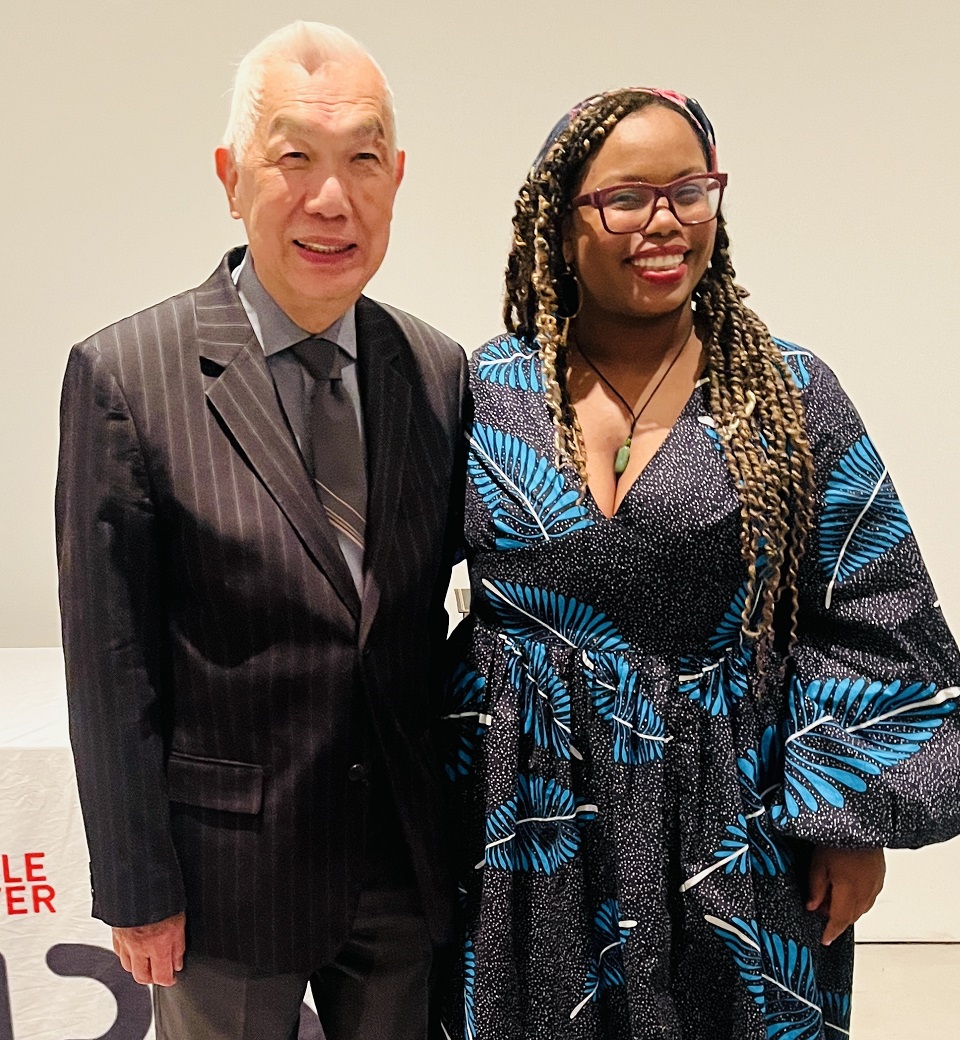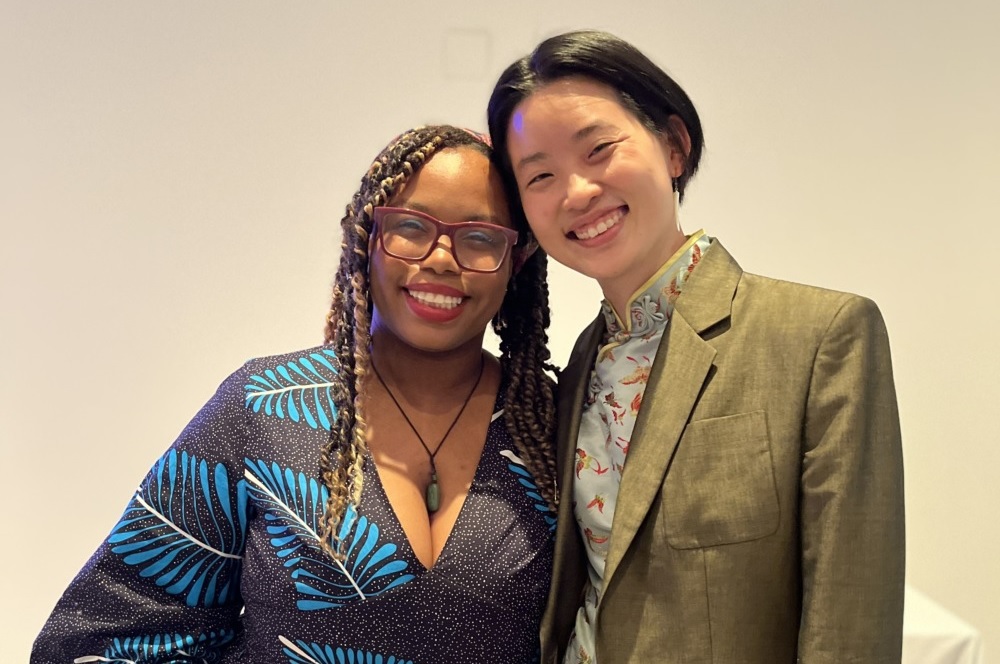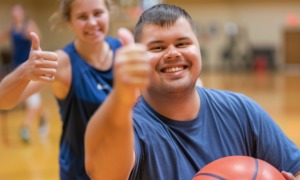Eight Chinese lanterns with burnt orange flames adorned the right side of an image that popped up on Facebook. Yellow lettering across the image’s ebony background spelled “Black Heroes of Chinatown National.”
“Huh?”
That’s the question a, perhaps, curious commenter wrote below the pop-up, posted by People Matter to publicize a celebration of Black change-makers in a Chicago neighborhood largely populated by Chinese immigrants and Chinese Americans.
The idea of spotlighting Black activists in that kind of neighborhood may seem incongruous to some, but it’s an outgrowth of an intentional partnership for organizations such as People Matter. Launched in winter 2019 by a Black woman and an Asian American woman, both 27, People Matter echoes cross-racial collaboration extending back to the 1950s and 60s. Back then, for example, Asian American activists Yuri Kochiyama and Grace Lee Boggs and Black American Malcolm X, together, protested U.S. racial discrimination and involvement in the Vietnam War.
Today, in addition to People Matter in Chicago, Asian-Black coalitions include such groups as Freedom Inc. in Wisconsin. In Georgia, the Asian American Advocacy Fund lends its support to Black Live Matters. Collectively, those and similar organizations are addressing issues including police brutality and racial profiling, voter suppression, hate crimes, immigration, housing loss and gentrification. and the Asian American Advocacy Fund in Georgia, which also are addressing issues including police brutality and racial profiling, voter suppression, hate crimes, immigration, housing loss and gentrification.
What’s fueling the momentum, in part, are overt examples of anti-Asian and anti-Black bias and violence:
- The 2020 vigilante killing of Ahmaud Arbery in Georgia and the police slayings of Breonna Taylor in Kentucky and George Floyd in Michigan; each of them was unarmed and Black.
- The 2021 shootings of six Asian women and two others at Atlanta-area spas.
- An 18-year-old white supremacist gunman’s slaying of 10 Black people in Buffalo, N.Y. in May 2022.
- Hate crimes, particularly attacks against Asian seniors and Asian American women, that surged amid COVID-19 and continue to this day.
“[There’s] an opportunity for us to really come together and to move toward the kind of change that both Black and Asian communities have actually been fighting for, for decades,” said Vina Kay, 54, the vice president of movement capacity building for Race Forward, a multiracial organization with offices in New York City and Oakland, Calif. “This moment teaches us that solidarity is absolutely necessary … We don’t win alone, we win together.”
Launching, then growing an Asian-Black organization
Since Consuela Hendricks and Angela Lin started People Matter in Chicago more than two years ago, that nonprofit’s staff has grown to a total of six part- and full-time workers, organizing and educating youth in everything from social, economic and political community advocacy to how to build and maintain gardens.
Shanaya Riggs, 17, one of the teens in People Matter’s Pop-Up Community Garden program, said she was bullied as a child but has cultivated resilience and resolve through her involvement with People Matter. “We could change the world if we could get along with each other. Just introduce yourselves. Build relationships,” said Riggs, whose father is Chinese-American father and mother is African-American.
At People Matter’s Black Heroes of Chinatown National event, Hendricks, who was among Black activists heralded at celebrations in Chinatowns of San Francisco, Oakland, Chicago and New York City said the recognition means so much to her.
“A lot of my chosen family are Chinese,” said Hendricks, who, as teen, started volunteering with such organizations as the Coalition for a Better Chinese American Community.
As co-founders and co-presidents of People Matter, Hendricks and Lin facilitate workshops on identity, awareness, history, anti-Blackness and xenophobia.
“We sort of have a framework,” said Lin, who is Chinese American, “that anti-Blackness, xenophobia and capitalism are the roots of white supremacy, and anti-Blackness is one of the foundations of white supremacy … Learning about Asian American identity through a Black liberation lens is important to being able to work with Black folks in a really intentional and informed way.”
Those explorations, Hendricks added, require that people of color also examine their racial biases. “I meet a lot of Asian Americans who are honest,” Hendricks said, “and are, like, ‘Yes, my community is anti-Black. And this is what needs done in my community.’ And I meet a lot of Black folks that are honest, as well, saying, ‘I guess xenophobia is in my community. And it’s wrong the way we treat y’all when you enter our community.’”
Without that kind of candor, she added, there can be no cross-racial collaboration.
Recognizing diversity and tensions, while working to unite
In recent years, there’s been a shift away from “putting all people of color into one group,” said Zon Moua, 31, the former director of youth organizing and current queer justice director for Madison, Wisc.-based Freedom Inc., a Black- and Southeast Asian-helmed nonprofit.
“We’re really intentional about naming and saying that, ‘Yes, we experience racism. Yes, we experience patriarchal violence,’” said Moua, 31, a Hmong American. “And it looks different in each of our communities.
“And we need to … be intentional about making room and space for our specific communities to be able to have these conversations — to be able to work on being politicized around these things and also begin healing — before we can even start that solidarity work across racial and gender and sexual orientation.”
Moua, who has been working with Freedom Inc. since she was a teen, dismisses some people’s tendency to compare traumas endured by communities of color and other marginalized groups as a harmful exercise in “oppression Olympics.”
“We’re all surviving under these oppressive systems, and there is a spectrum of violence,” she said. “ … Who is the closest to like extreme violence? And who is a bit more far removed from there? If we’re talking about how we want to center the most impacted, and the most impacted should lead, are we actually able to name these things?”
Even as some Black and Asian American activists are hopeful about what can be achieved by coalescing, they also say it’s crucial to acknowledge a history of tension between both communities. There have been, for examples, the months-long fallout from the Los Angeles shooting of Latasha Harlins by Soon Ja Du in 199 and recent attacks on Asian Americans by Black assailants.
But there also are what many consider to be shared trauma of segregation and racial exclusions, codified in U.S. law, and mob lynching of Blacks and of Asians.
People Matter Outreach Coordinator Jessica Foster, 21, who is Black, said, “Having that solidarity is really important because it only tells both communities that ‘I see you, we see each other.’ We also have similar experiences. Why fight each other and have this tension, when there’s a bigger power at play that is causing us to do this against each other?”

Erin Chan Ding
Longtime Chicago Chinatown community leader C.W. Chan and his mentee Consuela Hendricks, People Matters, co-founder, at Black Heroes of Chinatown National celebration.
It’s crucial for predominantly Asian, Black and Latino neighborhoods on the city’s South Side to work together on civic endeavors like political redistricting and ensuring the city’s public schools equitably serve all populations, said C.W. Chan, 77, a longtime leader of Chicago’s Chinatown, who has mentored Hendricks and nominated her for one of the Black Heroes of Chinatown National awards.
“We have a shared destiny,” said Chan, co-founder of the Chinese American Service League and board member of the Coalition for a Better Chinese American Community. “And young people say, ‘We have to do something!’ We can really bring up the whole South Side together.”
In these times, organizer Moua said she’s excited by Generation Z, whose oldest members are 25, because they fully claim themselves and their complex, yet singular identities as Black, multiracial, Asian American, nonbinary, LGBTQ and so forth. Who they are has become foundational to their advocacy.
“They’re really pushing us to go beyond what we’ve been able to imagine. I see this really unapologetic, ‘This is who I am,’” Moua said. “And when you show up, you have to show up as yourself. And it’s no more, ‘I’m an ally to you.’ But it’s ‘I’m coming, and I’m showing up because I’m fighting for you.’”
***
Chicago-based, award-winning journalist Erin Chan Ding’s byline has appeared in, among other publications, the Detroit Free Press, Chicago Tribune, Los Angeles Times, New York Times and Washington Post.






























